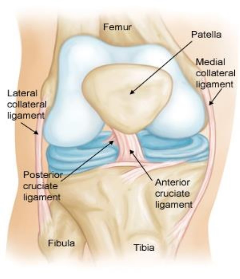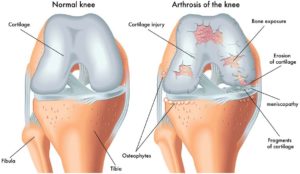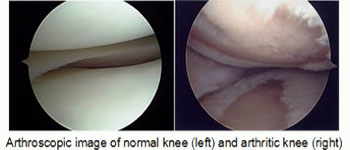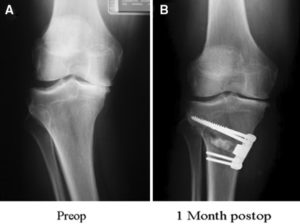Knee pain is the most common reason for a visit to the Orthopaedic surgeon’s office. Arthritis is the inflammation of one or more of your joints. Pain, swelling, and stiffness are the primary symptoms of arthritis. Any joint in the body may be affected by the disease, but it is particularly common in the knee.
The most common types of arthritis are osteoarthritis and rheumatoid arthritis, but there are more than 100 different forms. While arthritis is mainly seen in adults, there are some forms, which can affect the children. Although there is no cure for arthritis, there are many treatment options available to help manage pain and keep people staying active.
The knee is the largest and strongest joint in your body. It has three bones: The lower end of the femur (thighbone), the upper end of the tibia (shinbone), and the patella (kneecap). The bones never come in contact with each other. This is due to the presence of a smooth slippery substance on the inside of each bone, which acts like a cushion. It is called cartilage.
The inside of the joint is lined by a thin membrane called the synovial membrane. This membrane releases a fluid that lubricates the cartilage and reduces friction.
 Description:
Description:
Three major forms of arthritis are osteoarthritis, rheumatoid arthritis and post-traumatic arthritis.
The major types of arthritis that affect the knee are osteoarthritis, rheumatoid arthritis, and posttraumatic arthritis.
Osteoarthritis:
Osteoarthritis is the most common form of arthritis in the knee. It is a degenerative,”wear-and-tear” type of arthritis that occurs most often in people 50 years of age and older, but may occur in younger people, too.
In osteoarthritis, the cartilage in the knee joint gradually wears away. As the cartilage wears away, it becomes frayed and rough, and the protective space between the bones decreases. This can result in bone rubbing on bone, and hence cause pain.

Rheumatoid arthritis:
Rheumatoid arthritis is an autoimmune disease. This means that the immune system starts destroying body’s own tissues. Rheumatoid arthritis is a chronic disease that affects multiple joints throughout the body, including the knee joint. It frequently affects the same joint on both the sides of the body. In rheumatoid arthritis the synovial membrane that covers the knee joint begins to swell, This results in knee pain and stiffness.
Post traumatic arthritis:
This type of arthritis occurs few months- few years following an injury to the knee joint. For example, a broken bone may damage the joint surface and lead to arthritis years after the injury. Meniscal tears and ligament injuries can cause instability and additional wear on the knee joint, which over time can result in arthritis.
Pain and stiffness are the cardinal symptoms of arthritis. Generally, the pain develops gradually over time, although sudden onset is also possible. There are other symptoms, as well:
-
- The joint may become stiff and swollen, making it difficult to bend and straighten the knee.
- Pain and swelling may be worse in the morning, or after sitting or resting.
- Vigorous activity may cause pain to flare up.
- Loose fragments of cartilage and other tissue can interfere with the smooth motion of joints. The knee may “lock” or “stick” during movement. It may creak, click, snap or make a grinding noise (crepitus).
- Feeling of weakness or buckling in the knee.
- Many people with arthritis note increased joint pain with cold weather.

Diagnosis of arthritis:
Your surgeon will perform a detailed physical examination and may request you to undergo imaging studies like X-rays and ocassionally a MRI or a bone scan.
Treatment of arthritis:
There is no cure for arthritis, that means the damage to the cartilage cannot be reversed by any means. We do have means to re-grow degenerate cartilage at present. However, certainly arthritis can be well managed and pain can be controlled, so that it does not interfere with your daily activities.
Here are a few things that can be done:
- Activity modification: Switch from high impact activities like running and jumping to low impact activities like cycling and swimming.
- Loose weight: loosing weight reduces load on the knee joint, thus reducing pain.
- Physical therapy: physical therapy can reduce pain and improve flexibility and strength in the joint.
- Assistive devices like cane, shock absorbing foot wear, knee sleeves and braces can improve quality of life and assist you in your activities of daily living.
Medications:
As said before, no medications can regrow diseased cartilage. Medications are preferably used as less frequently as possible because of possible side effects on the kidney and liver. Various types of medications are available
- Paracetamol: This is available as an over the counter drug and preferably used as a first line drug when required.
- NSAIDS: These are non steroidal anti-inflammatories. They are meant to reduce the inflammation in the joint. They can frequently have side effects, especially on using for a long term. Hence it is advised they are consumed under supervision.
- Cortico-steroids can sometimes be injected into the joint to help inflammation in the joint.
There are a number of disease modifying drugs that are newly introduced. They are called - DMARDS, which modify the body’s immune response. Because there are many different drugs today for rheumatoid arthritis, a rheumatology specialist is often required to effectively manage medications.
- Glucosamines: these are the substances found naturally in joint cartilage. can be taken as dietary supplements. Although some patient reports indicate that these supplements may relieve pain, there is no scientific evidence to support the use of glucosamine and chondroitin sulfate to decrease or reverse the progression of arthritis.
- Visco-supplementation: viscosupplements are injections that can be given into the joint that help relieve pain and improve mobility.
Your doctor may recommend surgery if your pain from arthritis causes disability and is not relieved with nonsurgical treatment. You doctor will discuss the most appropriate surgery for you.
 Arthroscopy. During arthroscopy, doctors use small incisions and thin instruments to diagnose and treat joint problems. This usually involves two or three puncture holes made over the knee joint and is a minimally invasive surgery. It is most often performed as a day care surgery.
Arthroscopy. During arthroscopy, doctors use small incisions and thin instruments to diagnose and treat joint problems. This usually involves two or three puncture holes made over the knee joint and is a minimally invasive surgery. It is most often performed as a day care surgery.
Cartilage grafting. Normal, healthy cartilage tissue may be taken from another part of the knee or from a tissue bank to fill a hole in the articular cartilage. This procedure is typically considered only for younger patients who have small areas of cartilage damage.
Synovectomy. The joint lining damaged by rheumatoid arthritis is removed to reduce pain and swelling.
 Osteotomy. In a knee osteotomy, either the tibia (shinbone) or femur (thighbone) is cut and then reshaped to relieve pressure on the knee joint. Knee osteotomy is used when you have early-stage osteoarthritis that has damaged just one side of the knee joint. By shifting your weight off the damaged side of the joint, an osteotomy can relieve pain and significantly improve function in your arthritic knee
Osteotomy. In a knee osteotomy, either the tibia (shinbone) or femur (thighbone) is cut and then reshaped to relieve pressure on the knee joint. Knee osteotomy is used when you have early-stage osteoarthritis that has damaged just one side of the knee joint. By shifting your weight off the damaged side of the joint, an osteotomy can relieve pain and significantly improve function in your arthritic knee
Total or partial knee replacement (arthroplasty): If all the above methods fail, and the pain is unrelenting, your doctor may recommend a knee replacement. Knee replacement traditionally a very successful operation and with advances in technology it has become more efficient and safe. It mitigates the pain from arthritis and helps you get back to your activities. In this operation, your surgeon will remove the damaged cartilage and bone, and then position new metal or plastic joint surfaces to restore the function of your knee.

